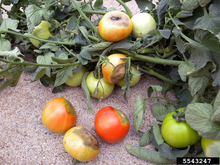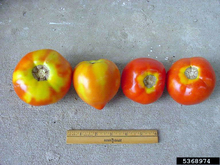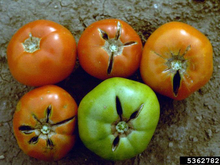If you have been able to water your vegetable garden, 2021 has been a great year for growing tomatoes. The drought has meant there is little water available to kickstart plant disease, so while August is typically when diseases like early blight take out plants, this year most tomato plants are still green and productive.
After heatwaves slowed down ripening, tomato harvest is in full swing. Some gardeners may have noticed some quality issues with the fruit as they harvest them.
While the first instinct is often that the plant is sick and we need to spray something, most of the fruit issues we are seeing are caused by a combination of weather, tomato variety, and our gardening practices.
It's been dry, so we’re seeing blossom end rot
In the first picking of tomatoes, it is common to see tomatoes with blossom end rot. Blossom end rot occurs when calcium doesn’t reach the fruit as it first starts to develop, causing the blossom end (or bottom) of the fruit to become scabby, discolored, hard, and exposed to fungi.
Often we see blossom end rot not because of a calcium deficiency, but because it is just plain hard for plants to move calcium around, especially when water is limited.
Think of people sitting in a row at a theater. For those at the edges, it is easy for them to get to their seats, but for those in the middle, it is hard, especially if they have to wade through people who’ve already sat down at the edge of the rows. Most nutrients are like the people at the edges, where it is easy for them to move and get to where they need to be in the plant. Calcium is like people sitting in the middle of the row, where it takes time and is kind of annoying to get to their spots. Because of the chemical structure of calcium molecules, plants can really struggle to uptake and move calcium where it is needed, even if the soil has plenty of calcium.
Going back to our theater metaphor, think of water as an usher who can help people find their row and get those already seated to stand up so people can get to the middle of the row. Providing a consistent supply of water during periods of hot weather helps plants power through and get calcium to the developing fruit.
If you see tomatoes on the plant with blossom end rot, remove them so that the plant focuses its energy on harvestable fruit.
It’s been hot, so we are seeing yellow shoulders and white interiors
We have also seen tomatoes with firm, yellowed tops and hard, white interiors. These are signs of two poorly understood physiological disorders - creatively named yellow shoulders and internal white tissue. We often see these issues when temperatures are over 90°F and in tomato fruit exposed to direct sunlight.
Variety definitely plays a role (though you won’t find this information in a seed catalogue), and some theorize plant fertility may be part of the equation.
There can be a temptation to let fruit sit on the plant as we wait for them to turn red, but for tomatoes with these physiological disorders, full red ripeness will never happen. Instead, leaving the fruit on the vine allows them to become overripe and vulnerable to opportunistic fruit rots.
What can you do with these tomatoes? Hone your knife skills. Areas with yellow shoulders can be easily cut off, and the fruit is safe to eat (though sometimes bland).
Some parts of Minnesota are finally getting some rain, so get ready for fruit cracking
Tomatoes experience fruit cracking when they grow quickly as they near maturity. This can be caused by an influx of water (see: rain) or temperature fluctuations. How much a tomato fruit will crack is dependent on how stretchy and strong the skin of the fruit is, which is affected by variety, plant nutrition, and where the tomato fruit is on the plant.
- Modern varieties have been bred to experience less fruit cracking than older varieties or heirlooms.
- Plants that are grown in gardens with lots of nitrogen and less potassium are more susceptible to fruit cracking.
- Individual fruit in direct sunlight experience more heat, thus more temperature fluctuation, than fruit in the shade, and are more likely to crack.
Tomato fruit cracks can provide an entry point for fungi that will cause the fruit to break down, but the fruit are still generally good to eat.
Want to stop these issues next year? Check into how you are gardening.
While these issues are weather-dependent, good gardening practices can reduce the chances that we see these issues next year.
- Get a soil test so you can fertilize your plants appropriately.
- Prune plants to promote overall plant health.
- Prune in a way so that fruit will be shaded.
- Make a note of which varieties you like and which ones have issues, and try out some new varieties next year.
- Learn about how water infiltrates and holds onto soil so you can water the right amount.
- Try out a mulch that will hold onto water during dry periods.
Bogash, S., & Orzolek, M. (n.d.). Yellow Shoulder on Tomato. http://www.hort.cornell.edu/expo/proceedings/2012/Greenhouse%20and%20High%20Tunnels/High%20Tunnels%20Bogash.pdf
Jones, J. B., Zitter, T. A., Momol, M. T., & Miller, S. A. (2014). Compendium of tomato diseases and pests. APS Press/The American Phytopathological Society.




